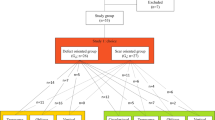Abstract
A survey was carried out to ascertain the preference for donor site scar orientation in patients undergoing pedicled latissimus dorsi breast reconstruction and their views on breast reconstruction in general. One hundred twelve women (59 Chinese, 53 Western) completed the questionnaire. Participants were asked to state their preferred scar orientation (i.e., oblique, horizontal, or vertical) based on photographs showing the position of the scars. Demographic information and views on issues surrounding breast reconstruction in general were also collected. Data was analyzed non-parametrically with chi-square test and t test. The mean age of participants was 39.5 years (20–73 years). Seventy-seven percent of the participants would opt for an immediate breast reconstruction if offered (p < 0.001). Eighty-six percent would have objection to the use of silicone implant as a whole or part of a reconstruction (p < 0.001). Vertical and horizontal scars were the preferred orientation, with no women choosing the oblique orientation as their first choice (p < 0.001). The non-Chinese of 40 years or older, as well as Chinese women from all age groups, preferred the horizontal scar (p < 0.05). We demonstrated that both culture and age impact on the preferred scar orientation in breast reconstruction. Women in the age group we commonly reconstruct favored the horizontal scar. However, the younger women of non-Chinese origin tended to favor the vertical scar.





Similar content being viewed by others
References
Adams WP Jr., Lipschitz AH, Ansari M, Kenkel JM, Rohrich RJ (2004) Functional donor site morbidity following latissimus dorsi muscle flap transfer. Ann Plast Surg 53(1):6–11
Aitken ME, Mustoe TA (2002) Why change a good thing? Revisiting the fleur-de-lis reconstruction of the breast. Plast Reconstr Surg 109(2):525–533 (discussion 534–538)
Baumholtz MA, Al-Shunnar BM, Dabb RW (2002) Boomerang flap reconstruction for the breast. Ann Plast Surg 49(1):44–48 (discussion 48–49)
Biggs TM, Cronin ED (1981) Technical aspects of the latissimus dorsi myocutaneous flap in breast reconstruction. Ann Plast Surg 6(5):381–388
Bostwick J 3rd, Jurkiewicz MJ (1980) Recent advances in breast reconstruction: transposition of the latissimus dorsi muscle singly or with the overlying skin. Am Surg 46(10):537–547
Broadbent TR, Woolf RM (1983) Breast reconstruction: a better skin pattern. Aesthetic Plast Surg 7(3):145–148
Callaghan CJ, Couto E, Kerin MJ, Rainsbury RM, George WD, Purushotham AD (2002) Breast reconstruction in the United Kingdom and Ireland. Br J Surg 89(3):335–340
Chau MS, Mok TS, Kwan WH, Yeo W, Zee B (2005) Knowledge, perception and attitudes of Hong Kong Chinese women on screening mammography and early breast cancer management. Breast J 11(1):52–56
Clough KB, Louis-Sylvestre C, Fitoussi A, Couturaud B, Nos C (2002) Donor site sequelae after autologous breast reconstruction with an extended latissimus dorsi flap. Plast Reconstr Surg 109(6):1904–1911
Dean C, Chetty U, Forrest AP (1983) Effects of immediate breast reconstruction on psychosocial morbidity after mastectomy. Lancet 1(8322):459–462
Germann G, Steinau HU (1996) Breast reconstruction with the extended latissimus dorsi flap. Plast Reconstr Surg 97(3):519–526
Hokin JA (1983) Mastectomy reconstruction without a prosthetic implant. Plast Reconstr Surg 72(6):810–818
Kelly MB, Searle A (1998) Improving the donor site cosmesis of the latissimus dorsi flap. Ann Plast Surg 41(6):629–632
Kronowitz SJ, Kuerer HM (2006) Advances and surgical decision-making for breast reconstruction. Cancer 107(5):893–907
Laitung JK, Peck F (1985) Shoulder function following the loss of the latissimus dorsi muscle. Br J Plast Surg 38(3):375–379
Marshall DR, Anstee EJ, Stapleton MJ (1984) Soft tissue reconstruction of the breast using an extended composite latissimus dorsi myocutaneous flap. Br J Plast Surg 37(3):361–368
Maxwell GP (1981) Latissimus dorsi breast reconstruction: an aesthetic assessment. Clin Plast Surg 8(2):373–387
McManus P, Sterne GD, Fatah F, Lee MJ (2003) Immediate breast reconstruction in the West Midlands: a survey of current practice. Br J Plast Surg 56(6):567–570
Menke H, Erkens M, Olbrisch RR (2001) Evolving concepts in breast reconstruction with latissimus dorsi flaps: results and follow-up of 121 consecutive patients. Ann Plast Surg 47(2):107–114
Morrow M, Mujahid M, Lantz PM, Janz NK, Fagerlin A, Schwartz K et al (2005) Correlates of breast reconstruction: results from a population-based study. Cancer 104(11):2340–2346
National Institute for Health and Clinical Excellence (2000) Referral guidelines for suspected cancer (April). National Institute for Health and Clinical Excellence, London
Ruetschi MS, LeWinn LR, Chaglassian TA (1981) Variation of latissimus dorsi skin island design for post mastectomy reconstruction. Ann Plast Surg 6(3):171–187
Russell RC, Pribaz J, Zook EG, Leighton WD, Eriksson E, Smith CJ (1986) Functional evaluation of latissimus dorsi donor site. Plast Reconstr Surg 78(3):336–344
Sternberg EG, Perdikis G, McLaughlin SA, Terkonda SP, Waldorf JC (2006) Latissimus dorsi flap remains an excellent choice for breast reconstruction. Ann Plast Surg 56(1):31–35
Tansini I (1896) Nuovo processo per l’amputazione della mammaella per cancre. Reforma Medica 3:12
Wu TY, West B, Chen YW, Hergert C (2006) Health beliefs and practices related to breast cancer screening in Filipino, Chinese and Asian–Indian women. Cancer Detect Prev 30(1):58–66
Yau TK, Lau Y, Kong J, Yeung MW, Chan M, Sze WM et al (2002) Breast conservation treatment in Hong Kong—early results of 203 patients: retrospective study. Hong Kong Med J 8(5):322–328
Author information
Authors and Affiliations
Corresponding author
Rights and permissions
About this article
Cite this article
Ngan, P.G., Jayagopal, S., George, E.N. et al. Preference for donor site scar orientation in pedicled latissimus dorsi breast reconstruction. Eur J Plast Surg 30, 189–194 (2007). https://doi.org/10.1007/s00238-007-0172-4
Received:
Accepted:
Published:
Issue Date:
DOI: https://doi.org/10.1007/s00238-007-0172-4




